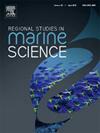Macrobenthos communities and ecological quality assessment in the subtropical estuary: Insights for management of marine protected area
IF 2.1
4区 环境科学与生态学
Q3 ECOLOGY
引用次数: 0
Abstract
The marine protected area in the Jianjiang River Estuary was established in 2011; however, subsequent research on the ecological health of the estuarine biological community has been lacking, making it difficult to scientifically evaluate or inform the management of the reserve. In this study, we assessed the composition and diversity of macrobenthic communities at ten different sites in the Jianjiang River estuary reserve in both Spring and Autumn and used three biotic indices to evaluate the ecological quality status (EcoQs) across the reserve. We identified 58 macrobenthic taxa, of which the largest proportion were Mollusca (48.28 %), followed by Annelida (27.59 %) and Arthropoda (18.97 %). Macrobenthic abundance and biomass varied among sites and seasons, and community composition was driven by different environmental variables in Spring and Autumn. With respect to our three indices of ecological quality, abundance-biomass comparison (ABC) curve analysis and the associated W-statistics indicated that macrobenthic communities in the reserve were undisturbed in the Spring but disturbed in Autumn. The AZTI marine biotic index (AMBI) indicated that most sites have high or good EcoQs, with higher EcoQs in the Spring, and the multivariate AMBI (M-AMBI) index similarly suggested that the average EcoQs were good in Spring but only moderate in Autumn. We suspect that the consistently lower EcoQs in Autumn across all sites were largely due to a 1-in-10-year flood discharge that occurred during our sampling year and disturbed sites near the river outflow. Overall, our results point towards specific, scientifically informed suggestions for future management of the Jianjiang River estuary reserve.
亚热带河口大型底栖动物群落与生态质量评价:对海洋保护区管理的启示
2011年建立了建江口海洋保护区;然而,由于缺乏对河口生物群落生态健康状况的后续研究,难以科学评价或为保护区管理提供信息。在春秋两季对建江口保护区10个不同地点的大型底栖生物群落组成和多样性进行了研究,并采用3种生物指标对保护区的生态质量状况进行了评价。共鉴定出58个大型底栖动物类群,其中软体动物(48.28 %)所占比例最大,其次是环节动物(27.59 %)和节肢动物(18.97 %)。大型底栖动物丰度和生物量在不同的立地和季节存在差异,群落组成受春季和秋季不同环境变量的驱动。在3个生态质量指标上,丰度-生物量比较(ABC)曲线分析和相关w统计表明,保护区大型底栖生物群落春季未受干扰,秋季受干扰。AZTI海洋生物指数(AMBI)显示,大多数样点的生态生态指数为高或好,春季生态生态指数较高;多元生态生态指数(M-AMBI)同样显示,平均生态生态指数为春季良好,秋季中等。我们怀疑,所有站点在秋季持续较低的ecoq主要是由于在我们的采样年发生的10年一遇的洪水排放和河流出水口附近的受干扰站点。总体而言,我们的研究结果为未来的建江口保护区管理提供了具体的、科学的建议。
本文章由计算机程序翻译,如有差异,请以英文原文为准。
求助全文
约1分钟内获得全文
求助全文
来源期刊

Regional Studies in Marine Science
Agricultural and Biological Sciences-Ecology, Evolution, Behavior and Systematics
CiteScore
3.90
自引率
4.80%
发文量
336
审稿时长
69 days
期刊介绍:
REGIONAL STUDIES IN MARINE SCIENCE will publish scientifically sound papers on regional aspects of maritime and marine resources in estuaries, coastal zones, continental shelf, the seas and oceans.
 求助内容:
求助内容: 应助结果提醒方式:
应助结果提醒方式:


